At WPBeginner, we use Cloudflare’s large, fast CDN to make our site faster for users all around the world. It’s like putting our website in the fast lane of the information superhighway.
Cloudflare is one of the best WordPress CDN services available on the market. They offer a free CDN that speeds up your website and powerful security features for small business websites.
However, Cloudflare’s initial setup process can be difficult for new users.
In this guide, we’ll walk you through a complete Cloudflare setup in WordPress to help you improve your website speed.
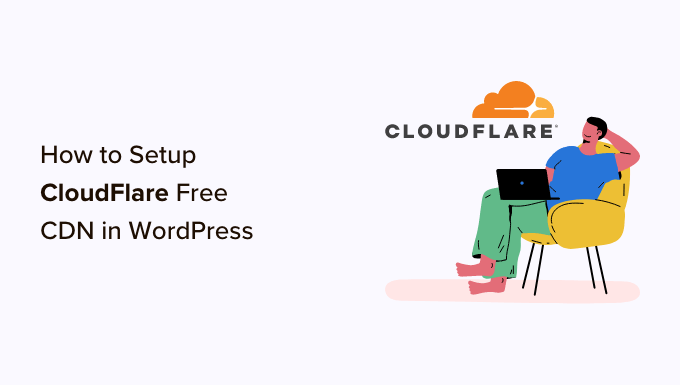
What Is a CDN?
A CDN or content delivery network is a system of distributed servers that helps deliver your website files faster to users based on their location.
Typically, a web hosting service serves your website visitors from a single location. All the users access the same server, no matter where they are located.
This can cause a delay in content delivery for users living further away from your website’s central hosting server.
That’s why CDNs set up multiple edge servers in different locations around the globe.
These CDN servers cache static content from your website’s origin server and present it to users when they visit your WordPress website.
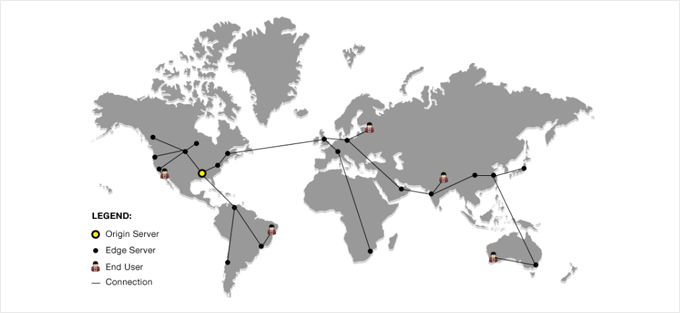
When there is a user request, the CDN server closest to the user’s location will handle it.
For example, if someone in the USA wants to access a UK-hosted website, then a CDN server in the USA will serve that request, not the main server in the UK.
With a CDN, all the user requests are handled by the nearest CDN servers. This reduces the physical distance between the visitors and your website’s server.
As a result, a CDN improves your website performance and speed for all users regardless of their geographic location.
A faster website also improves the user experience and can give your website a slight boost in SEO rankings. Using a CDN also reduces the load on your primary server and protects it from crashing during traffic spikes.
If you want to learn more, then see our guide on why you need a CDN for your WordPress blog.
What Is Cloudflare CDN?
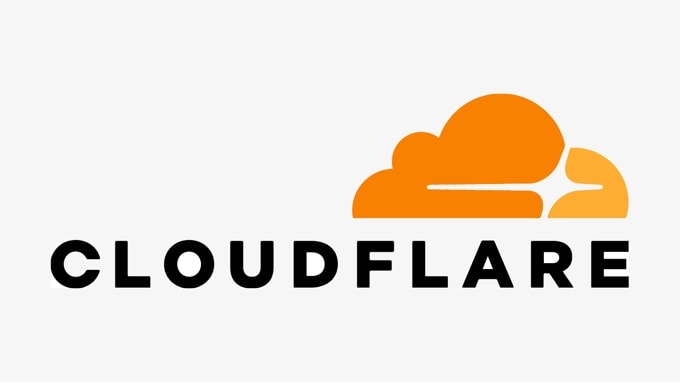
Cloudflare is one of the most popular free CDN providers available on the internet. It is a large network of globally distributed servers that automatically cache static content and deliver dynamic content quickly.
On top of a CDN service, Cloudflare is also a cloud-based website firewall and a distributed proxy server. It monitors all incoming traffic to your website and blocks suspicious traffic even before it reaches your server.
They offer a free basic plan that’s suitable for small business websites and blogs. They also offer paid plans starting at $20 per month.
Cloudflare is an excellent choice for small businesses looking for a free CDN. However, if you want to fully utilize all of Cloudflare’s features, then you will need the Business plan, which costs $200 per month.
Related: See our post on why WPBeginner switched from Sucuri to Cloudflare.
With that being said, let’s take a look at how to set up Cloudflare Free CDN in WordPress. You can use the quick links below to jump to the different parts of the tutorial:
Setting Up Cloudflare CDN in WordPress
To begin, you need to visit the Cloudflare website and click on the ‘Sign Up’ button.
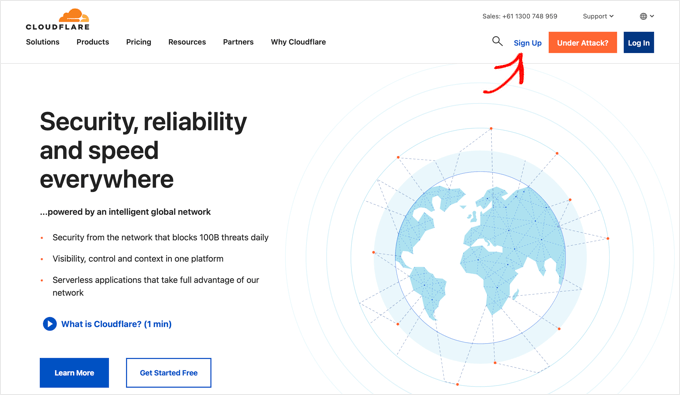
On the next page, you need to enter your email address and password to create a Cloudflare account.
Simply enter the information required, and then click on the ‘Sign up’ button.
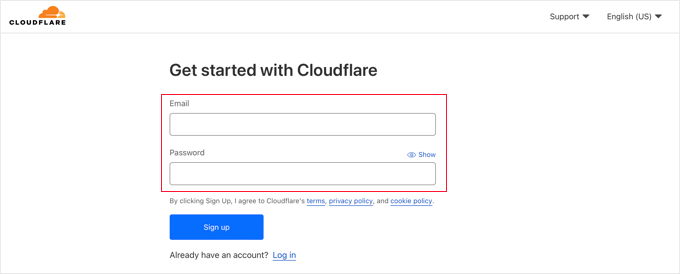
When you finish signing up, you will see a thank you page confirming that your Cloudflare account has been set up.
The next step is to add your website to Cloudflare. You should click the ‘Add a website or application’ button to get started.
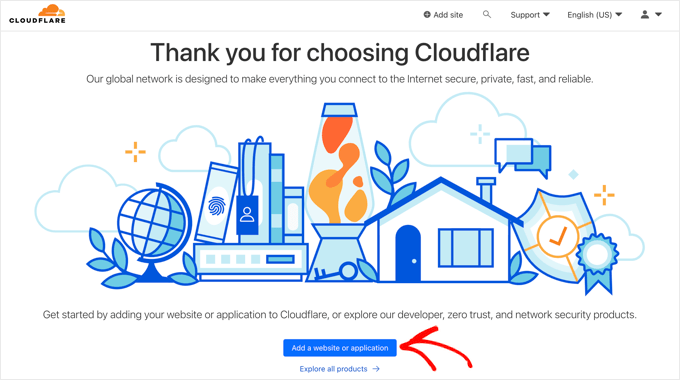
You can now enter your website into the ‘Enter your site’ field.
Make sure you only type your site’s domain name, such as example.com. You don’t need to type the full URL or any extra characters.
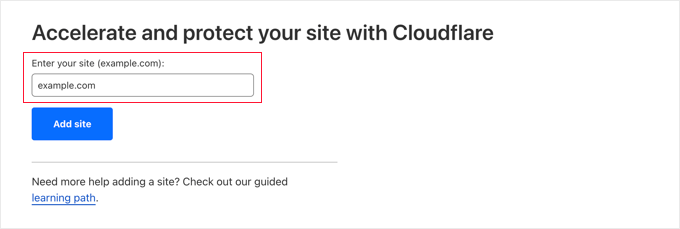
On the next screen, you will be asked to choose the type of Cloudflare plan you want.
For this tutorial, we will choose the free Cloudflare plan. Then, click the ‘Continue’ button.
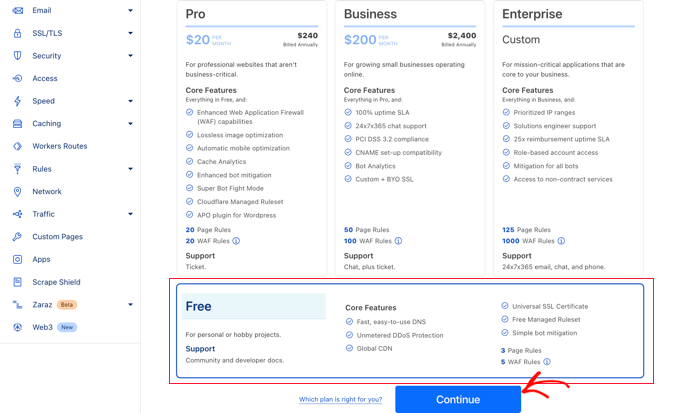
After that, Cloudflare will show you a list of all DNS records their systems found. These will include your subdomains as well.
The DNS records you want to be passed through Cloudflare should have an orange cloud icon. The DNS records that will bypass Cloudflare will have a gray cloud icon.
You need to review the list to make sure that your primary domain is active on Cloudflare with an orange cloud icon. Simply click the ‘Proxy status’ toggle to change the status.
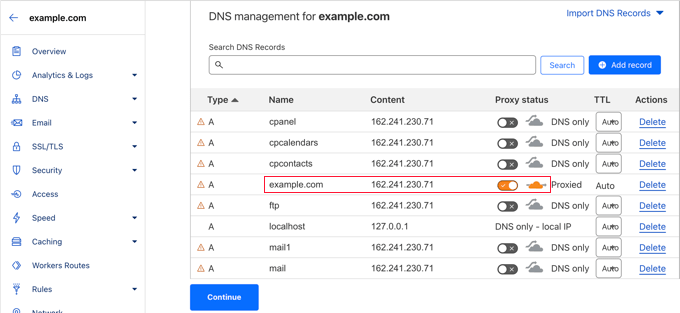
Once you have verified your DNS records, just click on the ‘Continue’ button at the bottom.
During the next step of your setup, Cloudflare will ask you to update your nameservers. You will be asked to change your nameservers and point them to Cloudflare nameservers.
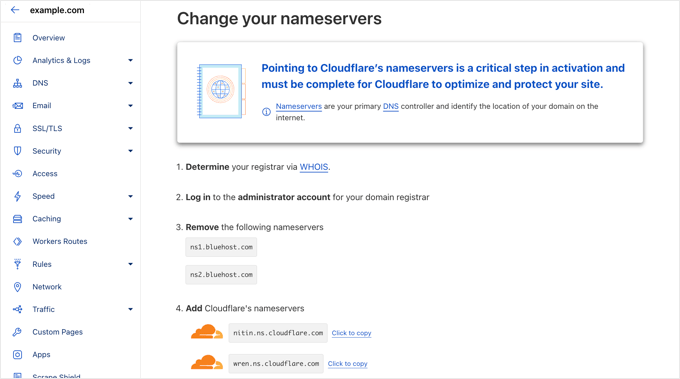
Note: Changing nameservers can take some time to propagate throughout the internet. During this time, your website may become inaccessible to some users.
You can change nameservers from your domain registrar account, like Domain.com.
Or, if you got a free domain from your web hosting provider like Bluehost, then you will have to change the name server by logging in to your hosting account.
For the sake of this tutorial, we will be showing you how to change the nameservers from the Bluehost control panel.
While the process is similar across hosting companies, you can always ask your hosting provider for detailed instructions for their control panel.
Once you are logged in to your Bluehost dashboard, go to the ‘Domains’ section and click the ‘Settings’ button next to your domain name.

Next, you need to scroll down to the Advanced Settings section and expand it by clicking the arrow on the right of the screen. This will show your website’s DNS settings, including the nameservers.
Next to ‘Nameservers (DNS), you should click the ‘Manage’ button.
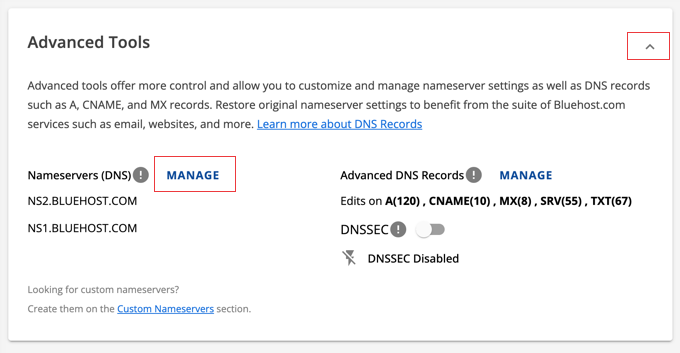
This will pop up a warning that only advanced users should update their nameservers.
You need to click the ‘Continue’ button to acknowledge this and move on to the next step.
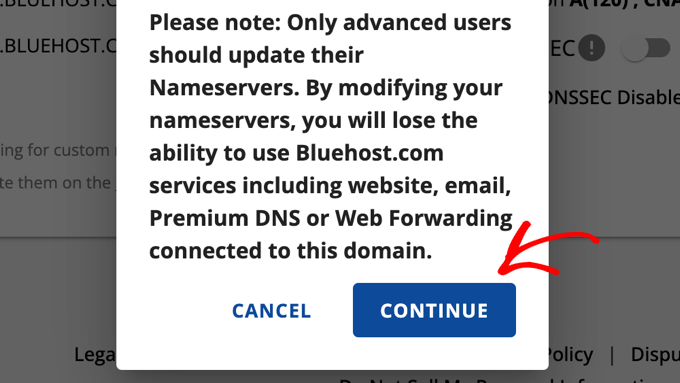
Next, you need to enter the nameservers provided by Cloudflare.
Then, click the ‘Save’ button.
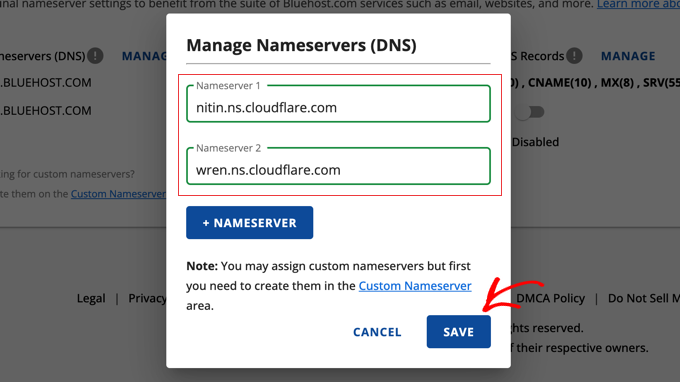
After that, you need to go back to the Cloudflare setup page and click the ‘Done, check nameservers’ button to finish the setup.
It will now check your new nameservers automatically.
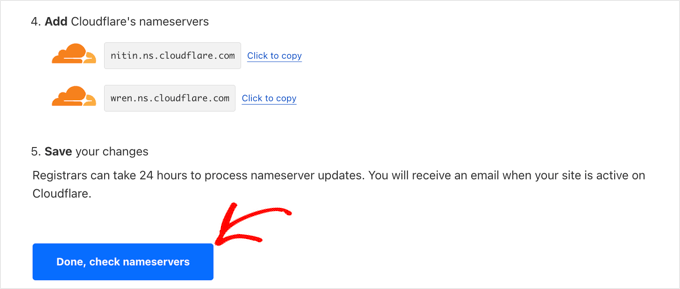
That’s it! It will take a few minutes to update your domain nameservers and activate Cloudflare.
Once activated, you will see the success message in your Cloudflare dashboard.

In the meantime, the Cloudflare Quick Start Guide will open automatically, and you can use it to customize your Cloudflare settings. We will show you how in the next section.
Note: The above screenshots show the Bluehost control panel. Your nameserver settings may look different if you are using a different hosting provider.
Configuring Cloudflare With the Quick Start Guide
The Cloudflare Quick Start Guide should have opened automatically after you clicked on the ‘Done, check nameservers’ button above. This setup wizard will help you improve the security and performance of your website.
The first setting is ‘Automatic HTTPS Rewrites’.
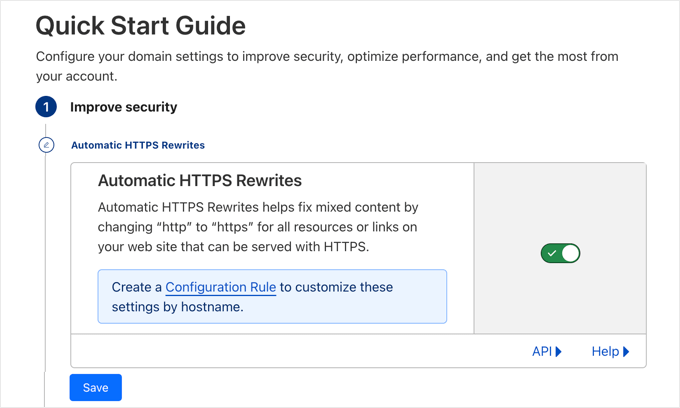
This will help you avoid the mixed content error in WordPress. It does this by automatically changing ‘http’ to ‘https’ in the URLs of all resources and links on your site that can be served with a secure ‘https’ URL.
This setting is on by default. We recommend you leave it on and click the ‘Save’ button.
The next setting is ‘Always Use HTTPS’.
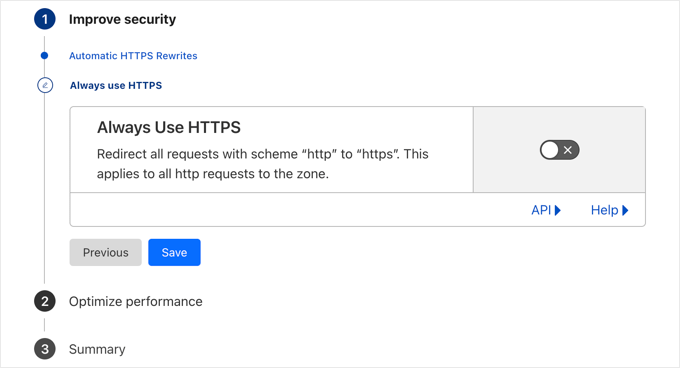
Some users have reported issues when using this setting with Cloudflare. This setting is disabled by default, and we recommend you leave it that way. We will show you how to redirect from HTTP to HTTPS using the All in One SEO plugin later in this article.
Now, you can click the ‘Save’ button to move on to the next option.
The next setting is Brotli compression.
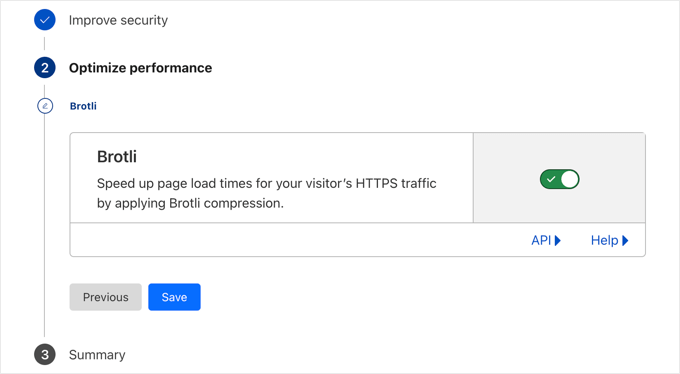
Cloudflare can use Brotli compression to unlock 15-20% speed improvements. This setting is on by default, and we recommend you leave it on.
Make sure you click the ‘Save’ button to store this setting.
Now, you will see a summary of what you have configured with the Quick Start Guide.
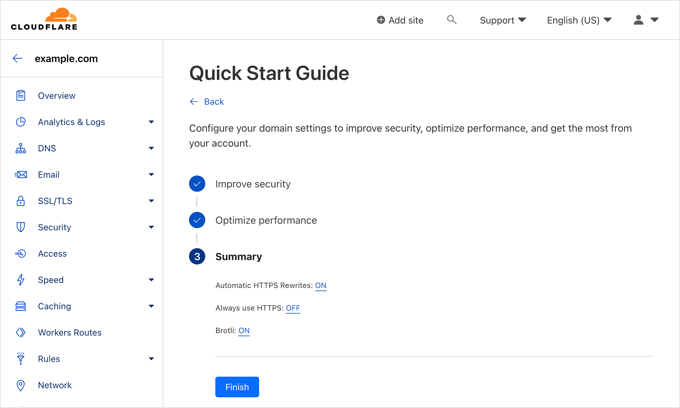
You should see:
- Automatic HTTPS Rewrites: ON
- Always Use HTTPS: OFF
- Brotli: ON
You have now completed the Quick Start Guide and can click the ‘Finish’ button. However, there are still some additional important settings that need to be configured.
Configuring Additional Important Cloudflare Settings
Your basic Cloudflare setup is complete, but there are a few essential settings you need to configure to keep your WordPress site secure.
1. Secure Your WordPress Login Page
You can set up page rules to customize how Cloudflare works on specific pages on your site. This is especially useful for securing critical pages such as the login page and wp-admin area.
The Cloudflare free account allows you to set up 3 page rules. If you want to add more page rules, then you need to pay $5 per month for 5 extra rules.
First, you need to click the ‘Rules’ option in the menu on the left of the page. After that, you can click the ‘Create Page Rule’ button.
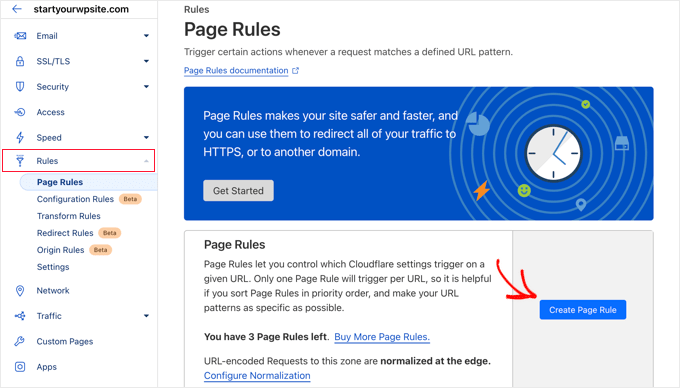
Now you can set up 3 different page rules. You can start by creating a rule that secures your WordPress login page.
Simply add the following settings below to secure your website:
- Page URL: example.com/wp-login.php*
- Settings: Security Level – High
When you are done, just click ‘Save and Deploy’ to store and activate the rule.
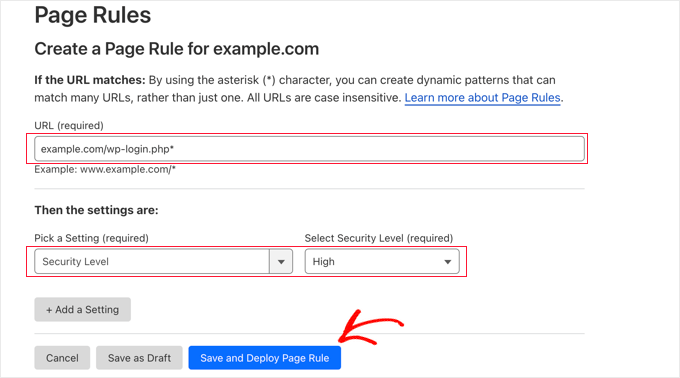
2. Exclude the WordPress Dashboard from Cloudflare
You will be returned to the Page Rules page, where you can see your first rule listed.
Now, you can create a second rule to exclude the WordPress dashboard from Cloudflare caching and enable high security.
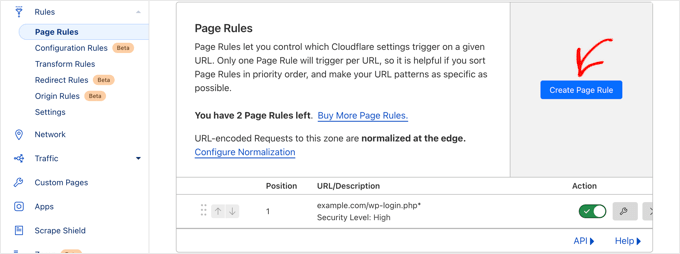
You’ll need to click on the ‘Create New Rule’ button to create your second rule.
After that, you need to type the following settings into the rule. You can click the ‘+ Add a Setting’ button to add new rows for additional settings:
- Page URL: example.com/wp-admin*
- Settings: Security Level – High
- Cache Level – Bypass
- Disable Performance
- Disable Apps
When you are done, make sure you click ‘Save and Deploy’ to add the new rule.
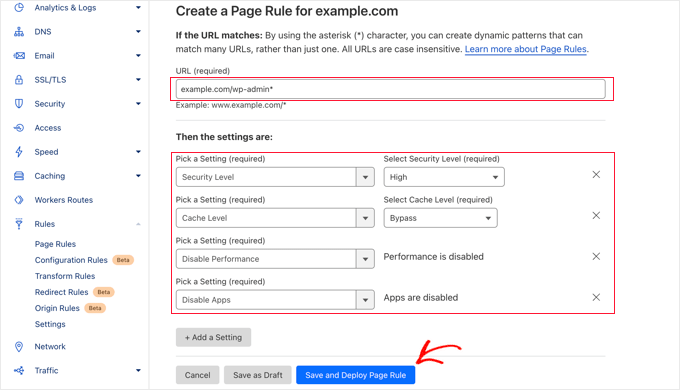
3. Configure SSL Certificate Settings
Another important setting is the SSL certificate available in the ‘SSL/TLS’ menu on the left.
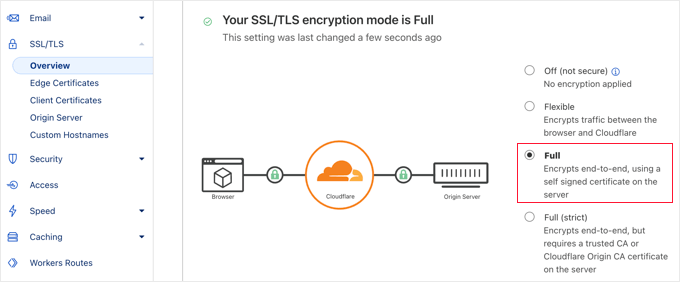
Make sure to click the ‘Full’ radio button if you are already using SSL.
If you don’t have an SSL certificate, then see our guide on how to get a free SSL certificate for your website.
Once you are done, Cloudflare will provide the essential green padlock in your visitors’ address bar to signify that your website is secure.
4. Redirect from HTTP to HTTPS Using All in One SEO
We mentioned earlier that we don’t recommend using Cloudflare’s ‘Always Use HTTPS’ feature. A great alternative is to use the All in One SEO plugin. It’s the best SEO plugin for WordPress, used by over 3 million sites.
The first thing you need to do is activate and install the All in One SEO plugin. For more details, see our guide on how to install a WordPress plugin.
After that, navigate to All in One SEO » General Settings and then enter your license key into the ‘License Key’ box and click ‘Connect’.

You can find your license key in your account profile on the All in One SEO website.
Next, navigate to All in One SEO » Redirects and then click the ‘Full Site Redirects’ menu navigation option.
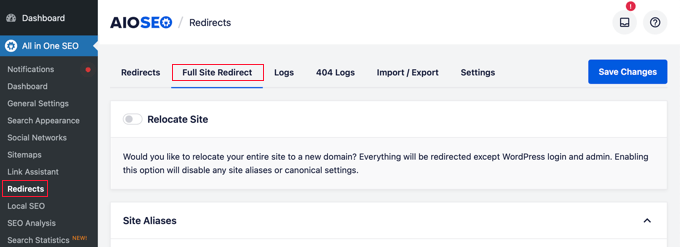
You will need to scroll down the page until you find the ‘Canonical Settings’ toggle. You should click this toggle so that it turns blue.
Next, turn on the ‘Redirect from HTTP to HTTPS’ toggle. This will create a redirect from HTTP to HTTPS, making sure that your visitors always have a secure connection to your website.

When you are done, make sure to click the ‘Save Changes’ button at the bottom or top of the screen to store this setting.
Optimizing Cloudflare for WordPress Using a Plugin
Cloudflare offers a dedicated WordPress plugin for one-click WordPress-optimized settings.
The plugin lets you quickly set up Cloudflare on your WordPress site, add web application firewall (WAF) rulesets, automatically purge the cache, and more.
To get started, install and activate the Cloudflare plugin on your website. For more details, see our step-by-step guide on how to install a WordPress plugin.
Once done, you need to visit Settings » Cloudflare in your admin panel to configure the Cloudflare settings.
On the settings page, you will see a ‘Create Your Free Account’ button and a sign-in option for existing accounts. Simply click the ‘Sign in here’ link.
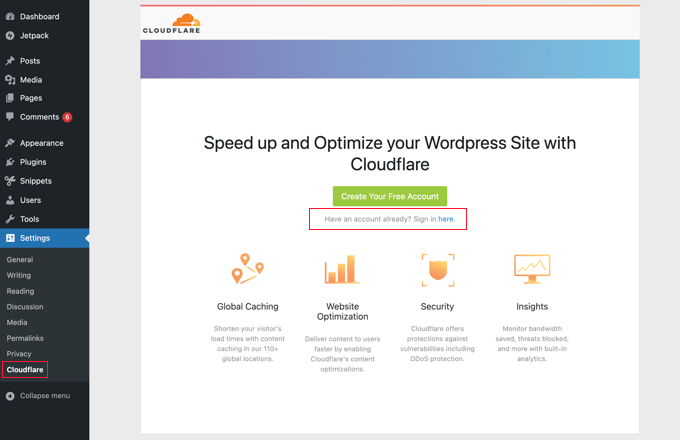
On the next screen, you will need to enter your Cloudflare email and API key.
Click the ‘Get your API key from here’ link.
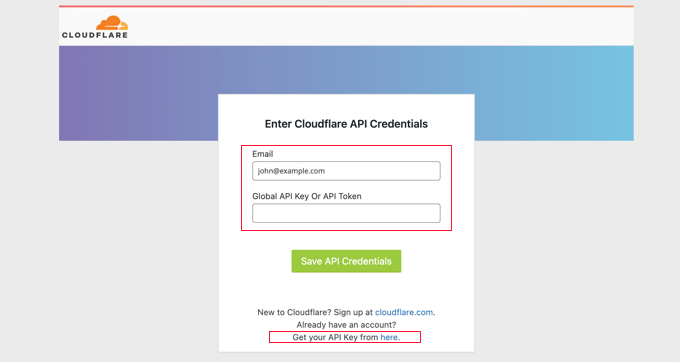
This will bring up a popup for your account area on the Cloudflare website.
Make sure you are on your ‘My Profile’ page, and then click on the ‘API Tokens’ tab in the left sidebar.
After that, go to the ‘Global API Key’ section and click on the ‘View’ button.
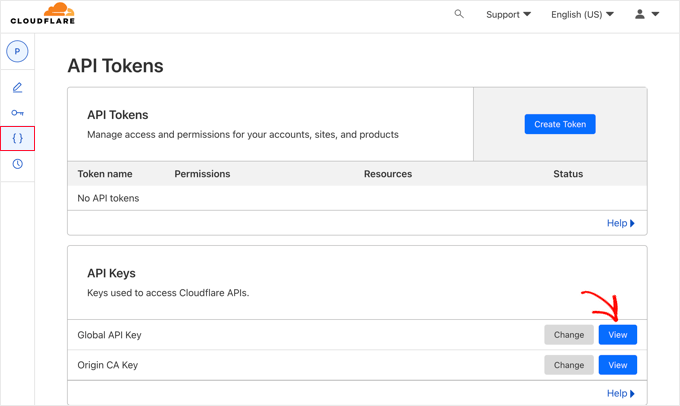
This will open a popup and display your API key.
Simply click on the key to copy it.
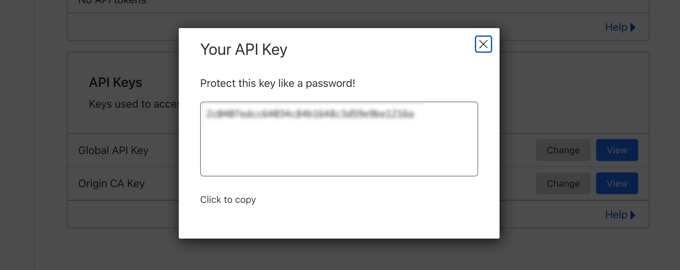
Next, you need to come back to your WordPress dashboard and enter your email address and API key.
Then, click the ‘Save API Credentials’ button.
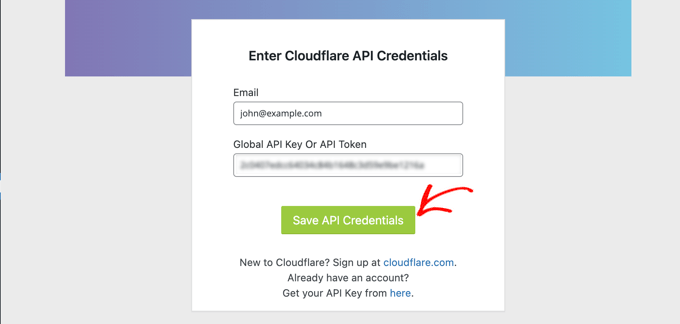
After that, the Cloudflare settings will appear on your dashboard.
From here, you can apply a single-click WordPress optimization, purge the cache, enable automatic cache, and more.
To optimize your WordPress site, just click the ‘Apply’ button next to ‘Apply Default Settings’.
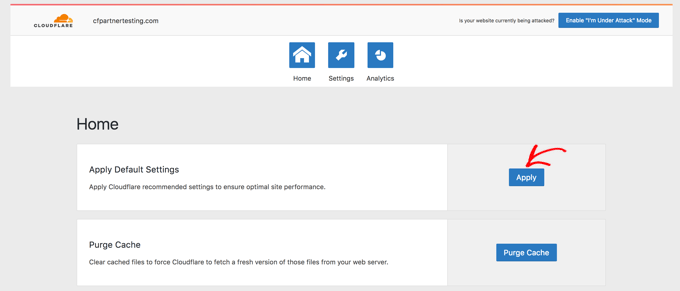
Next, click on the ‘Settings’ menu option.
Here, you will find more site optimization settings.
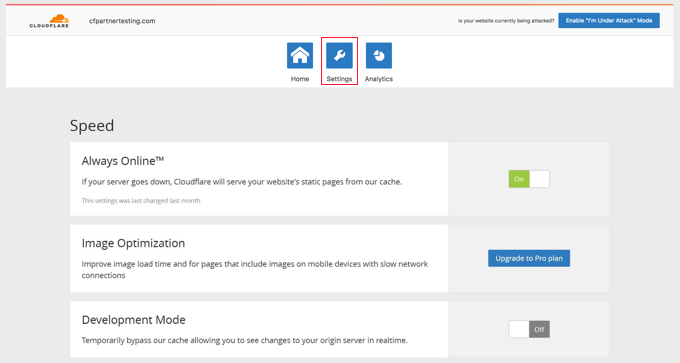
You can scroll down on this screen to find the ‘Security’ section.
By default, the security level is medium. To improve your website’s security, you can select ‘High’ from the dropdown list.

We hope this article helped you to learn how to set up Cloudflare free CDN in WordPress. You may also want to see our ultimate WordPress security guide and our expert picks for the best WordPress security plugins to further protect your website.
If you liked this article, then please subscribe to our YouTube Channel for WordPress video tutorials. You can also find us on Twitter and Facebook.





Syed Balkhi says
Hey WPBeginner readers,
Did you know you can win exciting prizes by commenting on WPBeginner?
Every month, our top blog commenters will win HUGE rewards, including premium WordPress plugin licenses and cash prizes.
You can get more details about the contest from here.
Start sharing your thoughts below to stand a chance to win!
Gabriel Ahulo says
Finally, I’ve been able to integrate cloud flare to my site .
WPBeginner Support says
Glad our guide was helpful!
Admin
Nelson says
My hosting provider connected my website over Cloudflare CDN.
But main problem is with website speed.
Speed with direct access 100% and when accessed via CDN 85%. How can it be fixed?
WPBeginner Support says
It would depend on the reason why it says that the speed is lower, we would recommend taking a look at our guide below for understanding and using speed tests:
https://www.wpbeginner.com/beginners-guide/how-to-properly-run-a-website-speed-test-best-tools/
Admin
Andrew Hansen says
My hosting plan through Host gator says it has cloudflare installed. Is that good, or should I uninstall it through the hosting plan and manually add it so i can customize my options?
WPBeginner Support says
It would depend on how Cloudflare is set up on your account, if you have access to cloudflare’s settings then you can continue to use what is on your account without worrying.
Admin
Andrew Hansen says
I do not have control over settings.
WPBeginner Support says
Jus to be safe, check with your host as there may be a hidden settings area for Cloudflare in the hosting settings.
Andrew Hansen says
I checked the information regarding cloudflare through Hostgator. you can manage what level caching (assets only, assets and web pages, or assets and web pages extended) and you can clear the cache, but hostgator says under the cons of using it “No option to customize – Currently, you cannot customize cache settings (for example, which content gets cached, the cache timing, etc.) for the CDN.”
Jiří Vaněk says
I use Cloudflare DNS along with their CDN. The integration of Cloudflare CDN into the WP Rocket plugin, which I use for caching, is fantastic. The CDN can be linked with the caching plugin, allowing for the simultaneous clearing of both the website cache and the CDN cache with a single button in WP Rocket.
WPBeginner Support says
Connections like that to help simplify the process are very helpful
Admin
Ralph says
I plan on making website from europe server (cheaper) to US users and this guide is godsend! Even better it is possible to do it for free. Thank you for this detailed guide. It will definitely help me setting everything up as I never really understood how to do this. Every other guide was lacking details and was too general.
WPBeginner Support says
Glad to hear our guide was helpful
Admin
Salman says
Hi, I use the “WPS Hide Login” plugin. While creating a page rule for the login page should I use the default login URL or the new login URL which I am using with the help of the plugin?
WPBeginner Support says
If the login page is on a different URL you would want to set the page rule for the active login page that users would visit.
Admin
Neal Umphred says
Thanks for another useful how-to article!
Regarding the ‘Always Use HTTPS’ option, you wrote: “Some users have reported issues when using this setting with Cloudflare.”
What are those issues?
WPBeginner Support says
The errors vary between sites so we don’t have a specific list of errors to point to at the moment.
Admin
Sohil Jain says
If I setup comment on my main domain wil it will be setup automatically to subdomain too? Because I don’t want cloudflare setup to apply to subdomain as I only want on main domain. So where to click so that it will not apply to subdomain
Thanks
WPBeginner Support says
There is an option in Cloudflare to exclude a subdomain so you wouldn’t need to worry about that.
Admin
Evindu Shavinda says
I added Cloudflare to my website today. So, I had to remove my hosting’s nameservers & replace them with Cloudflare nameservers from my domain registrar.
This is the question – 1. So, how my hosting account still works? I have removed its nameservers from the domain registrar
Aftab says
Don’t worry about hosting. Cloudflare doesn’t modify or change your hosting configuration. Your site will be hosted on your current host only. The reason why cloudflare asks you to change the nameserver because it passes your site through their DNS. It routes your web traffic through the Cloudflare network. So they can proxy your traffic through their network. Cloudflare offers security, ddos protection to all the sites that are configured with their nameservers. You don’t need to spend a single penny to configure your site through network. It’s a part of the free plan. No matter how many sites you have.
Nina Cen says
When I tried to add the page rules for my wordpress login page, I got message “Not Acceptable! An appropriate representation of the requested resource could not be found on this server. This error was generated by Mod_Security.”
Is anything I did wrong? Or I just need to wait for a little while to try again?
WPBeginner Support says
You would want to check with your hosting company for that specific error as that normally means they have a security rule set to prevent certain things on your site.
Admin
Shyam says
I s there a way to turn off the second loading screen for security verification purposes and that CAPTCHA page which you have mentioned in the Cons of Cloudflare?
WPBeginner Support says
You should be able to change the settings to remove that if you wanted but you would want to check with CloudFlare for the current method.
Admin
Lou says
I’m setting up Cloudflare – thanks to your article! I’ve already got W3 super cache plugin – do I need both? Are they going to confuse each other? Total newb question I know!
WPBeginner Support says
They have slightly different functions and there is an integration so the two can work with each other without an issue.
Admin
Faith Nte says
Thank you for this guide. It helped me reduce the time my page loads
WPBeginner Support says
Glad our guide was helpful
Admin
Muntaha says
What if someone mistakenly adds the wrong parameters in page rules and then deployed it. Is there any way back to change page rules after deploying it?
WPBeginner Support says
You can change your settings after setting them if you need to.
Admin
bali kratom says
thanks for sharing this content
WPBeginner Support says
You’re welcome
Admin
Will says
Probably a noob question, but I have a lot of existing video and photo files on my site. Will they all be migrated to Cloudflare’s CDN or do I have to do that manually? I followed the setup steps, but my content still takes forever to load, and when I view its URL, it’s still showing my site’s URL and path.
WPBeginner Support says
You shouldn’t need to transfer your content, for the slow loading you may want to reach out to CloudFlare for them to take a look
Admin
Brooke says
Thanks so much for this, helps a lot!
Just to be clear, even though I’ve added my site to cloudflare, I still need to get an SSL cert separately? Cloudflare does not supply ssl cert?
Thanks again!
WPBeginner Support says
You would want to take a look again under the Configuring Most Important Cloudflare Settings section for CloudFlare’s SSL
Admin
Ibraham Aali says
Admin, kindly answer these question like
After changing the DNS, who is actually will my hosting provider? The hoster OR cloudflare and all editing can be done by same cpanel?
WPBeginner Support says
Your hosting provider would still be your hosting provider.
Admin
Soumya says
thank you very much, I was looking for a proper step-by-step Cloudflare set up! and TA DA!! you guys are savior.
It would be great if you publish about the best of cloudflare settings, from the plugin.
WPBeginner Support says
Glad you found our article helpful
Admin
Alabura says
Thank you for such a great publications, it really help me set up my cloud flare account easily. Keep the good work.
WPBeginner Support says
You’re welcome, glad our guide was helpful
Admin
Bryan Wagar says
Very helpful information and with the pictures for verification i could confirm everything instead of guessing, thankyou very much for compiling this! It is BRILLIANT
WPBeginner Support says
You’re welcome, glad our guide could be helpful
Admin
PKV says
superb guide, easy to follow thanks
WPBeginner Support says
Glad our guide was helpful
Admin
randhir singh says
I want to know which is the best CDN ? cloud Flare or max
WPBeginner Support says
Hi Randhir,
At WPBeginner, we recommend MaxCDN. However, if you want to use the free CDN, then Cloudflare can be a good solution.
Admin
anurag saxena says
If i will use cloudfare free version and will change the nameserver then it means my website will run on cloudfare server then how i can edit my website? through cloudfare or my present hosting provider? pls tell me detail.
andy says
The only reason I use cloudflare because you can hide where you hosting the site.
Mehmet says
i am wondering..
for cloudflare, we need to point the DNS to theirs..
so how we gonna use custom email set up using our own domain (which also need to point the DNS to the email provider) ?
as far as i know, we can’t use two DNS .. (actually we can, but it is expensive)
Aqib says
I am using custom email and cloudflare. Cloudflare doesn’t affect my custom email working.
Abhi says
If my domain is from go daddy and hostino is from inmotion hosting and I change my domain name server to my hosting now I want to join cloudfare to it then what can I do?
andy says
I try to help answer. from godaddy change nameserver to cloudflare, and from cloudflare, set up your DNS and point to your in motion hosting ip address.
Syed Shan says
After Setting Our Host DNS To Cloudfare DNS, Which bandwidth and storage will be used from our local hosting plan e.g godaddy, namecheap etc or Cloudfare ?
Haydrion Rayel says
The reasons why I don’t use cloudflare is because of changing the nameservers and second like in this article : it blocks some of the legitime users and that is what I really hate.
I don’t use third party websites where I don’t have full control of it. I saw a couple of times there are you human google click on pictures and it takes forever.
MaxCDN is the only option because you only have to add a cname .. but still ..
Haydrion Rayel says
The reasons why I don’t use cloudflare is because of changing the nameservers and second like in this article : it blocks some of the legitime users and that is what I really hate.
I don’t use third party websites where I don’t have full control of it. I saw a couple of times there are you human google click on pictures and it takes forever.
MaxCDN is the onlly option because you only have to add a cname .. but still ..
abhishek purohit says
My site is on wordpress and running on godaddy vps server with ssl certificate but it has lots of page load time, now, should I go for cdn cloud flare free account if yes than what about all static IP given with vps account , they will not useable and is vps based site need cloud flare ?
Munna Hossain says
Page loading time is an important issue to get good user experience. This LoudFlare helps us to increase the page loading. Can you tell me which one is better to improve page speed, plugin or CDN?
Iain says
HI
Just to let you know
I have had a joomla website working on the Free plan and SSL
Not sure if your previous post is now outdated but it is possible.
Regards
Mircea Pop says
You can use the provided Cloudflare SSL but you are unable to use your own SSL on free account
koushil says
bro can we use this for blogspot blog ?
King Rayhan says
of course why not
why not
Ikechukwu says
This was very helpful. Thanks.
munetsi says
i am actually caught in between-
which provider should i choose for my site,
between cloudfare or maxcdn
Editorial Staff says
We use MaxCDN for our sites.
Admin
SOTHEA says
This is truly awesome tip. Anyways, I have a question. If my website contents and domain name are hosted in different hosting companies. In this case, I need to change Name Servers to CloundFlare for both. Am I correct?
Anubhav says
Did you find the solution for this as i have different hosting provider and domain name provider is different .If you know the solution then please let me know
Ummi Mental says
after changing the DNS, who is actually will my hosting provider? The hoster OR cloudflare and all editing can be done by same cpanel?
Captain Asif says
Really very helpful article i have setup my wordpress site with cloudflare
Joe says
What minification services do you recommend that work well with Cloudfare? This is for a WordPress site that may have potentially high traffic spikes out of the blue. Thanks
bobzyouruncle says
I live at the bottom of Africa (Cape Town) with none of their servers close to me am I correct in thinking that Cloud Flare will slow down my website. Most of my traffic is local. I have the same issues with CDNs none of them are close to my location, Europe is the closest. Is my thinking correct?
Damon Billian says
CloudFlare would add a little latency because we currently don’t have any data centers in SA just yet (being looked at). Visitors from SA would currently hit a data center in Europe.
On the other hand, if you have visitors from a lot of other locations (EU, America, Asia, etc.), then the site would be faster for them.
munetsi says
was just checking ,looks like they have servers in johannesburg.
Adesanmi Adedotun says
I have heard about cloudflare but have not tried to make use of it, bout talking about the fact that my site might be down during the propagation of my name server,how long could this take?
WPBeginner Support says
It varies, it can take a few hours to a full day.
Admin
Einstein says
You will not experience any downtime while you switch to Cloudflare if you do it correctly.
Damon Billian says
You should not have any downtime at all switching to CloudFlare’s nameservers.
Robby McCullough says
I am a huge fan of CloudFlare. At my shop, we do a lot of sites for professional photographers. CF does an amazing job at making image heavy pages load in a snap!
One tip, don’t forget about CF’s developer mode when you’re making changes. I’ve bashed my head against the wall for some time when my CSS changes weren’t showing up — CF was serving a cached page!
Boby says
When my website has ‘heavy load’ CloudFlare will make the users access screenshot of the website.
Abhisek says
Cloudflare breaks my site’s design. I have a off-canvas menu and Cloudflare’s rocketloader and minification breaks ,y site’s design. So, I have to stick with basic W3 Total cache. Besides Cloudflare actually speeds up your site.
Damon Billian says
Those features are actually optional and easy to turn off. If you’re using a minify service already, then you don’t want to turn ours on as well (something eventually will break running two minify options at the same time). Rocket Loader would have the potential to impact JavaScript and jQuery & would generally impact something like widgets.
Joe says
What WordPress theme were you using? That way we can know to avoid using that theme with Cloudfare.